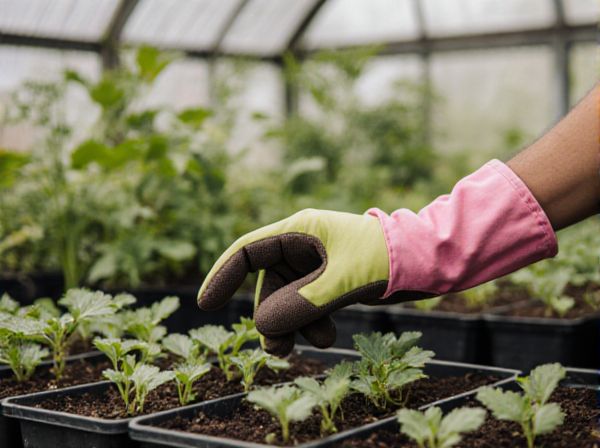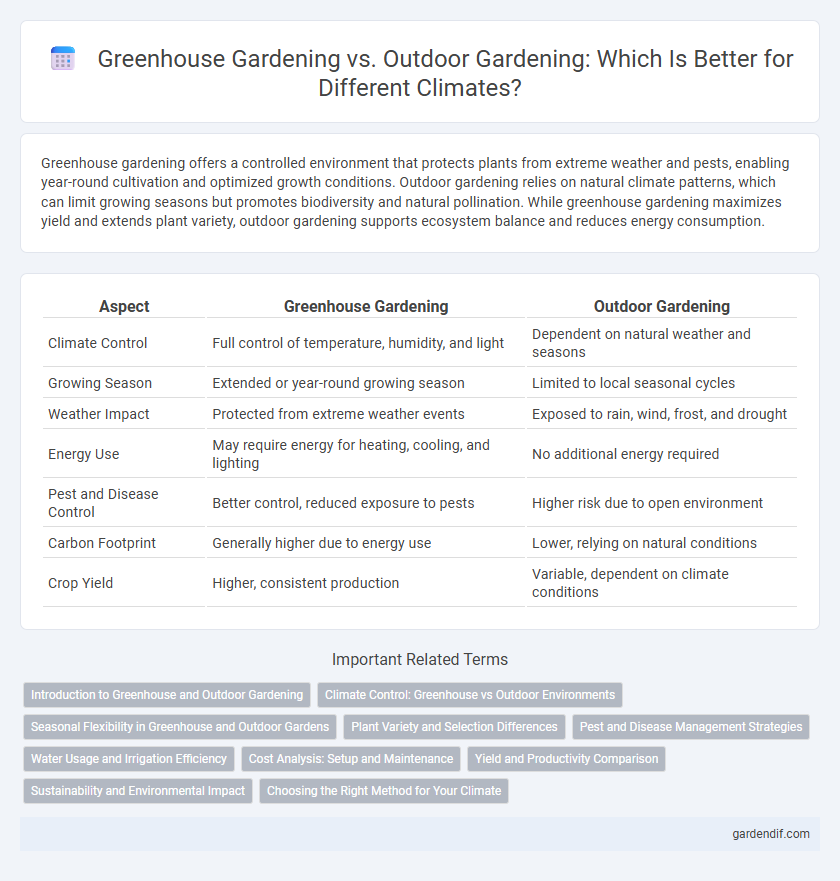
Greenhouse gardening vs Outdoor gardening Illustration
Greenhouse gardening offers a controlled environment that protects plants from extreme weather and pests, enabling year-round cultivation and optimized growth conditions. Outdoor gardening relies on natural climate patterns, which can limit growing seasons but promotes biodiversity and natural pollination. While greenhouse gardening maximizes yield and extends plant variety, outdoor gardening supports ecosystem balance and reduces energy consumption.
Table of Comparison
| Aspect | Greenhouse Gardening | Outdoor Gardening |
|---|---|---|
| Climate Control | Full control of temperature, humidity, and light | Dependent on natural weather and seasons |
| Growing Season | Extended or year-round growing season | Limited to local seasonal cycles |
| Weather Impact | Protected from extreme weather events | Exposed to rain, wind, frost, and drought |
| Energy Use | May require energy for heating, cooling, and lighting | No additional energy required |
| Pest and Disease Control | Better control, reduced exposure to pests | Higher risk due to open environment |
| Carbon Footprint | Generally higher due to energy use | Lower, relying on natural conditions |
| Crop Yield | Higher, consistent production | Variable, dependent on climate conditions |
Introduction to Greenhouse and Outdoor Gardening
Greenhouse gardening involves growing plants within a controlled environment that regulates temperature, humidity, and light to optimize plant growth year-round. Outdoor gardening relies on natural conditions and seasonal cycles, exposing plants to varying weather patterns and temperatures. Understanding the differences in environmental control and plant protection is essential for selecting the appropriate gardening method for specific crops and climates.
Climate Control: Greenhouse vs Outdoor Environments
Greenhouse gardening offers precise climate control by regulating temperature, humidity, and light, creating ideal growing conditions year-round regardless of external weather fluctuations. Outdoor gardening relies entirely on natural climate variations, exposing plants to seasonal changes, unpredictable weather, and potential environmental stressors. The ability of greenhouses to extend growing seasons and protect crops from extreme temperatures provides a significant advantage over traditional outdoor gardening in maintaining optimal plant health.
Seasonal Flexibility in Greenhouse and Outdoor Gardens
Greenhouse gardening offers significant seasonal flexibility by maintaining controlled temperatures and humidity levels, enabling year-round cultivation of plants irrespective of external weather conditions. Outdoor gardening depends heavily on natural climate cycles, limiting planting seasons based on regional frost dates and temperature fluctuations. Consequently, greenhouses extend growing periods and enhance crop yield consistency compared to outdoor gardens constrained by seasonal variability.
Plant Variety and Selection Differences
Greenhouse gardening enables cultivation of a wider variety of plants year-round, including exotic and heat-sensitive species, by controlling temperature, humidity, and light conditions. Outdoor gardening is typically limited to seasonal plants suited to local climate and soil conditions, restricting plant selection to native and hardier varieties. Controlled environments in greenhouses support optimal growth for diverse crops, while outdoor gardens rely on natural weather patterns influencing plant survival and productivity.
Pest and Disease Management Strategies
Greenhouse gardening offers controlled environmental conditions that reduce pest and disease incidence by limiting exposure to external pathogens and enabling targeted use of biological controls and integrated pest management techniques. Outdoor gardening requires more robust pest and disease management strategies, including the use of resistant plant varieties, crop rotation, and organic or chemical treatments to address diverse and unpredictable pest populations. Effective monitoring and early intervention are critical in both systems to prevent outbreaks and minimize crop loss.
Water Usage and Irrigation Efficiency
Greenhouse gardening significantly reduces water usage through controlled irrigation systems like drip irrigation, minimizing evaporation and runoff compared to outdoor gardening. Automated climate control in greenhouses optimizes water delivery based on plant needs, enhancing irrigation efficiency and conserving resources. In contrast, outdoor gardening often relies on more frequent watering that is susceptible to environmental factors, resulting in higher water consumption and lower efficiency.
Cost Analysis: Setup and Maintenance
Greenhouse gardening demands higher initial setup costs due to materials like glass or polycarbonate panels, ventilation systems, and climate control equipment, while outdoor gardening requires minimal investment, mainly in soil preparation and tools. Maintenance expenses for greenhouses include energy costs for heating, cooling, and automated watering systems, contrasting with outdoor gardening's reliance on natural weather conditions, which can reduce ongoing expenses. Long-term cost efficiency depends on crop type and yield, as greenhouses enable year-round growth but incur steady utility costs compared to predominantly seasonal outdoor gardening expenses.
Yield and Productivity Comparison
Greenhouse gardening offers controlled environmental conditions that enhance plant growth, resulting in higher yields and more consistent productivity compared to outdoor gardening. By regulating temperature, humidity, and light exposure, greenhouses extend growing seasons and reduce crop losses due to pests or weather fluctuations. Outdoor gardening yields are subject to seasonal variations and climatic unpredictability, often producing lower and less predictable harvests than greenhouse systems.
Sustainability and Environmental Impact
Greenhouse gardening enhances sustainability by optimizing resource use through controlled environments that reduce water waste and extend growing seasons, leading to higher yields per square foot compared to outdoor gardening. Outdoor gardening relies heavily on natural rainfall and solar energy but often faces challenges such as soil degradation and pest management that can increase chemical usage and environmental stress. Balancing these methods involves assessing carbon footprints, where greenhouses may consume more energy for climate control, whereas outdoor gardens support biodiversity and carbon sequestration naturally.
Choosing the Right Method for Your Climate
Selecting greenhouse gardening or outdoor gardening depends on your regional climate's temperature variations, humidity levels, and seasonal length. Greenhouse gardening offers controlled environments ideal for colder or unstable climates, enabling year-round cultivation and protection from pests and extreme weather. Outdoor gardening suits temperate climates with predictable seasons, allowing natural sunlight and rainfall to support plant growth with lower setup costs and maintenance.
Greenhouse gardening vs Outdoor gardening Infographic

 gardendif.com
gardendif.com